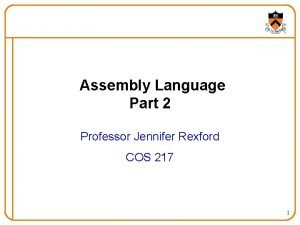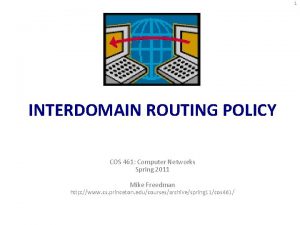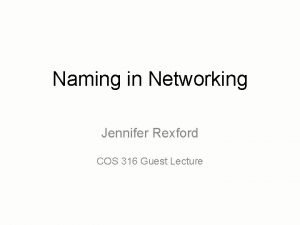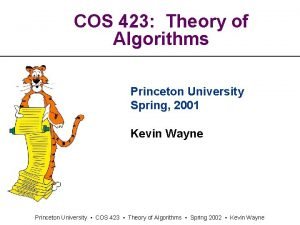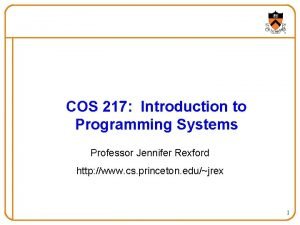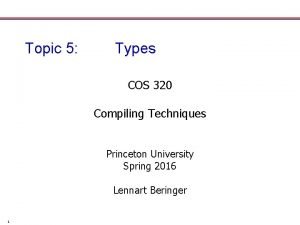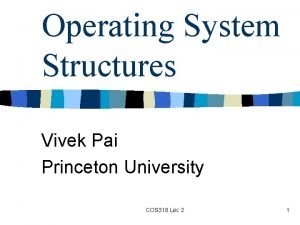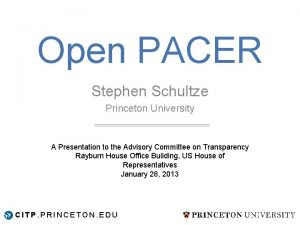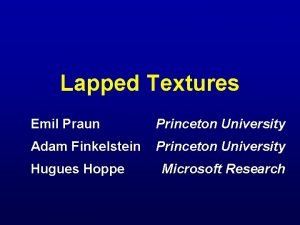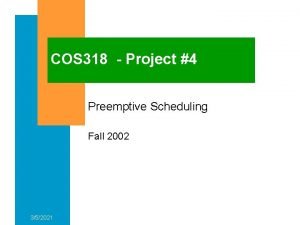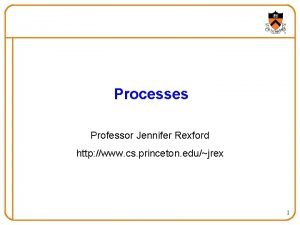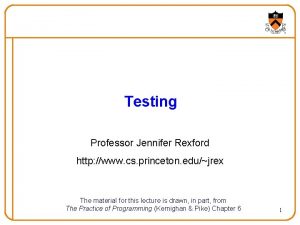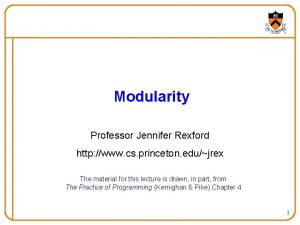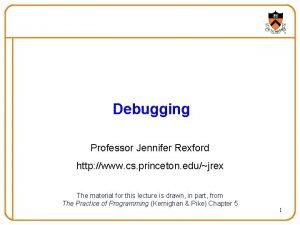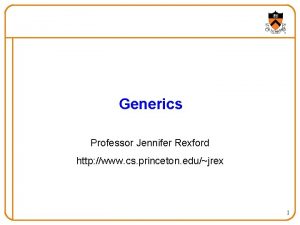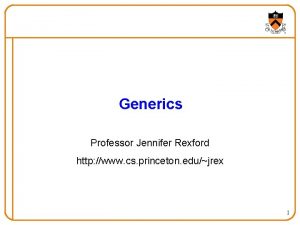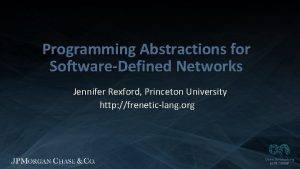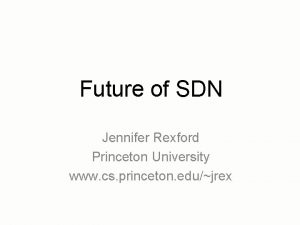Testing Professor Jennifer Rexford http www cs princeton

![Bugs, Bugs Everywhere “On two occasions I have been asked [by members of Parliament!], Bugs, Bugs Everywhere “On two occasions I have been asked [by members of Parliament!],](https://slidetodoc.com/presentation_image/2ee3ee988f8b1cd0a2c89055412989ae/image-2.jpg)








![Boundary Testing Example (cont. ) • Rewrite the code int i; char s[MAXLINE]; for Boundary Testing Example (cont. ) • Rewrite the code int i; char s[MAXLINE]; for](https://slidetodoc.com/presentation_image/2ee3ee988f8b1cd0a2c89055412989ae/image-11.jpg)

































- Slides: 44

Testing Professor Jennifer Rexford http: //www. cs. princeton. edu/~jrex The material for this lecture is drawn, in part, from The Practice of Programming (Kernighan & Pike) Chapter 6 1
![Bugs Bugs Everywhere On two occasions I have been asked by members of Parliament Bugs, Bugs Everywhere “On two occasions I have been asked [by members of Parliament!],](https://slidetodoc.com/presentation_image/2ee3ee988f8b1cd0a2c89055412989ae/image-2.jpg)
Bugs, Bugs Everywhere “On two occasions I have been asked [by members of Parliament!], ‘Pray, Mr. Babbage, if you put into the machine wrong figures, will the right answers come out? ’ I am not able rightly to apprehend the kind of confusion of ideas that could provoke such a question. ” ‒ Charles Babbage “Program testing can be quite effective for showing the presence of bugs, but is hopelessly inadequate for showing their absence. ” ‒ Edsger Dijkstra “Beware of bugs in the above code; I have only proved it correct, not tried it. ” ‒ Donald Knuth 2

Goals of this Lecture • Help you learn about: • Internal testing • External testing • General testing strategies • Why? • Hard to know if a large program works properly • When developing a large program, a power programmer expends at least as much effort writing test codeas he/she expends writing the program itself • A power programmer is comfortable with a wide variety of program testing techniques and strategies 3

Program Verification • Ideally: Prove that your program is correct • Can you prove properties of the program? • Can you prove that it even terminates? !!! Specification program. c Program Checker Right/Wrong ? 4

Program Testing • Pragmatically: Convince yourself that your program probably works Specification program. c Testing Strategy Probably Right/Wrong 5

External vs. Internal Testing • Types of testing • External testing • Designing data to test your program • Internal testing • Designing your program to test itself 6

External Testing • External testing: Designing data to test your program • External testing taxonomy (1) Boundary testing (2) Statement testing (3) Path testing (4) Stress testing • Let’s consider one at a time… 7

Boundary Testing (1) Boundary testing • “A testing technique using input values at, just below, and just above, the defined limits of an input domain; and with input values causing outputs to be at, just below, and just above, the defined limits of an output domain. ” � Glossary of Computerized System and Software Development Terminology • Alias corner case testing • Almost all bugs occur at boundary conditions • If program works for boundary conditions, it probably works for all others 8

Boundary Testing Example • Code to get line from stdin and put in character array int i; char s[MAXLINE]; for (i=0; (s[i]=getchar()) != 'n' && i < MAXLINE-1; i++) ; s[i] = '�'; printf("String: |%s|n", s); • Boundary conditions • Input starts with 'n' (empty line) • Prints empty string (“�”), so output is “||” • End of file before 'n‘ • Keeps calling getchar() and storing �in s[i] • End of file immediately (empty file) • Keeps calling getchar() and storing �in s[i] 9

Boundary Testing Example (cont. ) • Code to get line from stdin and put in character array int i; char s[MAXLINE]; for (i=0; (s[i]=getchar()) != 'n' && i < MAXLINE-1; i++) ; s[i] = '�'; printf("String: |%s|n", s); • Boundary conditions • Line exactly MAXLINE-1 characters long • Output is correct, with ‘�’ in s[MAXLINE-1] • Line exactly MAXLINE characters long • Last character on the line is overwritten, and newline never read • Line more than MAXLINE characters long • Some characters, plus newline, not read and remain on stdin 10
![Boundary Testing Example cont Rewrite the code int i char sMAXLINE for Boundary Testing Example (cont. ) • Rewrite the code int i; char s[MAXLINE]; for](https://slidetodoc.com/presentation_image/2ee3ee988f8b1cd0a2c89055412989ae/image-11.jpg)
Boundary Testing Example (cont. ) • Rewrite the code int i; char s[MAXLINE]; for (i=0; i<MAXLINE-1; i++) if ((s[i] = getchar()) == 'n') break; s[i] = '�'; • Another boundary condition: EOF for (i=0; i<MAXLINE-1; i++) if ((s[i] = getchar()) == 'n' || s[i] == EOF) break; s[i] = '�'; • What are other boundary conditions? • Nearly full • Exactly full • Over full This is wrong. Why? 11

Boundary Testing Example (cont. ) • Rewrite yet again for (i=0; ; i++) { int c = getchar(); if (c==EOF || c=='n' || i==MAXLINE-1) { s[i] = '�'; break; } else s[i] = c; } • There’s still a problem. . . Input: Four score and seven years Output: FourØ score anØ sevenØ yearsØ Where’s the ‘d’? 12

Ambiguity in Specification • If line is too long, what should happen? • Keep first MAXLINE characters, discard the rest? • Keep first MAXLINE-1 characters + '�' char, save the rest for the next call to the input function? • Probably, the specification didn’t even say what to do if MAXLINE is exceeded • Probably the person specifying it would prefer that unlimited-length lines be handled without any special cases at all • Moral: testing has uncovered a design problem, maybe even a specification problem! • Define what to do • Truncate long lines? • Save the rest of the text to be read as the next line? 13

Morals of This Little Story • Complicated, messy boundary cases are often symptomatic of bad design or bad specification • Clean up the specification if you can • If you can’t fix the specification, then fix the code 14

Statement Testing (2) Statement testing • “Testing to satisfy the criterion that each statement in a program be executed at least once during program testing. ” � Glossary of Computerized System and Software Development Terminology 15

Statement Testing Example • Example pseudocode: if (condition 1) statement 1; else statement 2; … if (condition 2) statement 3; else statement 4; … • Statement testing: Should make sure both “if” statements and all 4 nested statements are executed Requires two data sets; example: • condition 1 is true and condition 2 is true • Executes statement 1 and statement 3 • condition 1 is false and condition 2 is false • Executes statement 2 and statement 4 16

Path Testing (3) Path testing • “Testing to satisfy coverage criteria that each logical path through the program be tested. Often paths through the program are grouped into a finite set of classes. One path from each class is then tested. ” � Glossary of Computerized System and Software Development Terminology • Much more difficult than statement testing • For simple programs, can enumerate all paths through the code • Otherwise, sample paths through code with random input 17

Path Testing Example • Example pseudocode: if (condition 1) statement 1; else statement 2; … if (condition 2) statement 3; else statement 4; … Path testing: Should make sure all logical paths are executed • Requires four data sets: • condition 1 is true and condition 2 is true • condition 1 is true and condition 2 is false • condition 1 is false and condition 2 is true • condition 1 is false and condition 2 is false • Realistic program => combinatorial explosion!!! 18

Stress Testing (4) Stress testing • “Testing conducted to evaluate a system or component at or beyond the limits of its specified requirements” � Glossary of Computerized System and Software Development Terminology • What to generate • Very large inputs • Random inputs (binary vs. ASCII) • Use computer to generate inputs 19

Stress Testing Example 1 • Example program: #include <stdio. h> int main(void) { char c; while ((c = getchar()) != EOF) putchar(c); return 0; } Stress testing: Should provide random (binary and ASCII) inputs • Intention: Copy all characters of stdin to stdout; but note the bug!!! • Works for typical (human-generated) ASCII data sets • Random (computer-generated? ) data set containing byte 255 (decimal), alias 1111 (binary), alias �causes loop to terminate before end-offile 20

Stress Testing Example 2 • Example program: #include <stdio. h> int main(void) { short char. Count = 0; while (getchar() != EOF) char. Count++; printf("%hdn", char. Count); return 0; } Stress testing: Should provide very large inputs • Intention: Count and print number of characters in stdin • Works for reasonably-sized data sets • Fails for (computer-generated? ) data set containing more than 32767 characters 21

The assert Macro • An aside… • The assert macro • One actual parameter, which should evaluate to true or false • If true (non-zero): • Do nothing • If false (zero): • Print message to stderr “assert at line x failed” • Exit the process 22

Uses of assert • Typical uses of assert • Validate formal parameters size_t Str_get. Length(const char *str) { assert(str != NULL); … } • Check for “impossible” logical flow switch (state) { case START: … break; case COMMENT: … break; … default: assert(0); /* Never should get here */ } • Make sure dynamic memory allocation requests worked • (Described later in course) 23

Disabling asserts • Problem: asserts can be time-consuming • Want them in code when debugging, but… • Might want to remove them from released code • Bad “solution”: • When program is finished, delete asserts from code • But asserts are good documentation • And in the “real world” no program ever is “finished”!!! • Solution: Define the NDEBUG macro • Place #define NDEBUG at top of. c file, before all calls of assert • Makes the assert macro expand to nothing • Essentially, disables asserts 24

Disabling asserts (cont. ) • Problem: Awkward to place #define NDEBUG in only released code • Solution: Define NDEBUG when building • -D option of gcc defines a macro • gcc 217 -DNDEBUG myfile. c • Defines NDEBUG macro in myfile. c, just as if myfile. c contains #define NDEBUG • Controversy: Should asserts be disabled in released code? • Asserts are very time consuming => yes • Asserts are not very time consuming => sometimes unclear • Would user prefer (1) exit via assert, or (2) possible data corruption? 25

Internal Testing • Internal testing: Designing your program to test itself • Internal testing techniques (1) Testing invariants (2) Verifying conservation properties (3) Checking function return values (4) Changing code temporarily (5) Leaving testing code intact • Let’s consider them one at a time… 26

Testing Invariants (1) Testing invariants • Alias testing pre-conditions and post-conditions • Some aspects of data structures should not vary • A function that affects data structure should check those invariants at its leading and trailing edges • Example: “doubly-linked list insertion” function • At leading and trailing edges • Traverse doubly-linked list • When node x points forward to node y, does node y point backward to node x? • Example: “binary search tree insertion” function • At leading and trailing edges • Traverse tree • Are nodes are still sorted? 27

Testing Invariants (cont. ) • Convenient to use assert to test invariants #ifndef NDEBUG int is. Valid(My. Type object) { … Test invariants here. Return 1 (TRUE) if object passes all tests, and 0 (FALSE) otherwise. … } #endif void my. Function(My. Type object) { assert(is. Valid(object)); … Manipulate object here. … assert(is. Valid(object)); } Can use NDEBUG in your code, just as assert does 28

Verifying Conservation Properties (2) Verifying conservation properties • Generalization of testing invariants • A function should check affected data structures at leading and trailing edges • Example: Str_concat() function • At leading edge, find lengths of two given strings; compute sum • At trailing edge, find lengths of resulting string • Is length of resulting string equal to sum? • Example: List insertion function • At leading edge, find old length of list • At trailing edge, find new length of list • Does new length equal old length + 1? 29

Checking Return Values (3) Checking function return values • In Java and C++: • Method that detects error can “throw a checked exception” • Calling method must handle the exception (or rethrow it) • In C: • No exception-handling mechanism • Function that detects error typically indicates so via return value • Programmer easily can forget to check return value • Programmer (generally) should check return value 30

Checking Return Values (cont. ) (3) Checking function return values (cont. ) • Example: scanf() returns number of values read Bad code int i; scanf("%d", &i); Good code int i; if (scanf("%d", &i) != 1) /* Error */ • Example: printf() can fail if writing to file and disk is full; returns number of characters (not values) written Bad code? ? ? int i = 100; printf("%d", i); Good code, or overkill? ? ? int i = 100; if (printf("%d", i) != 3) /* Error */ 31

Changing Code Temporarily (4) Changing code temporarily • Temporarily change code to generate artificial boundary or stress tests • Example: Array-based sorting program • Temporarily make array very small • Does the program handle overflow? • Remember this for Assignment 3… • Example: Program that uses a hash table • Temporarily make hash function return a constant • All bindings map to one bucket, which becomes very large • Does the program handle large buckets? 32

Leaving Testing Code Intact (5) Leaving testing code intact • Leave important testing code in the code • Maybe surround with #ifndef NDEBUG … #endif • Control with –DNDEBUG gcc option • Enables/disables assert macro • Also could enable/disable your debugging code (see “Testing Invariants” example) • Beware of conflict: • Extensive internal testingcan lower maintenance costs • Code clarity can lower maintenance costs • But… Extensive internal testingcan decrease code clarity! 33

General Testing Strategies • General testing strategies (1) Testing incrementally (2) Comparing implementations (3) Automation (4) Bug-driven testing (5) Fault injection • Let’s consider one at a time… 34

Testing Incrementally (1) Testing incrementally • Test as you write code • Add tests as you create new cases • Test simple parts before complex parts • Test units (i. e. , individual modules) before testing the system • Do regression testing • A bug fix often creates new bugs in a large software system, so… • Must make sure system has not “regressed” such that previously working functionality now is broken, so… • Test all cases to compare the new version with the previous one 35

Testing Incrementally (cont. ) (1) Testing incrementally (cont. ) • Create scaffolds and stubs to test the code that you care about Function that calls code that you care about Scaffold: Temporary code that calls code that you care about Code that you care about Function called by code that you care about Stub: Temporary code that is called by code that you care about 36

Comparing Implementations (2) Compare implementations • Make sure that multiple independent implementations behave the same • Example: Compare behavior of your “decomment” vs. “gcc 217 –E” • Example: Compare behavior of your str. h functions vs. standard library string. h functions 37

Automation (3) Automation • Testing manually is tedious and unreliable, so… • Create testing code • Scripts and data files to test your programs (recall decomment program testing) • Software clients to test your modules (recall Str module testing) • Know what to expect • Generate output that is easy to recognize as right or wrong • Example: Generate output of diff command instead of raw program output • Automated testing can provide: • Much better coverage than manual testing • Bonus: Examples of typical/atypical use for other programmers 38

Bug-Driven Testing (4) Bug-driven testing • Find a bug => immediately create a test that catches it • Facilitates regression testing 39

Fault Injection (5) Fault injection • Intentionally (temporarily) inject bugs!!! • Then determine if testing finds them • Test the testing!!! 40

Who Tests What • Programmers • White-box testing • Pro: An implementer knows all data paths • Con: Influenced by how code is designed/written • Quality Assurance (QA) engineers • Black-box testing • Pro: No knowledge about the implementation • Con: Unlikely to test all logical paths • Customers • Field testing • Pros: Unexpected ways of using the software; “debug” specs • Cons: Not enough cases; customers don’t like “participating” in this process; malicious users exploit the bugs 41

Summary • External testing taxonomy • • Boundary testing Statement testing Path testing Stress testing • Internal testing techniques • • • Checking invariants Verifying conservation properties Checking function return values Changing code temporarily Leaving testing code intact 42

Summary (cont. ) • General testing strategies • Testing incrementally • Regression testing • Scaffolds and stubs • Automation • Comparing independent implementations • Bug-driven testing • Fault injection • Test the code, the tests – and the specification! 43

The Rest of This Week • Reading • Required: King book: chapters 8, 9, 11, 12, and 13 • Recommended: Kernighan and Pike: chapters 5 and 6 • Recommended: GNU Software: chapter 8 • Assignment #2 • One-week assignment on String Module • Due 9 pm Sunday February 22 • Checking your understanding of the first two weeks • Try questions 1, 3 e, 4, and 6 of the Spring 2008 midterm • Questions: http: //www. cs. princeton. edu/courses/archive/spring 08/cos 217/exam 1/spring 08 -cos 217 -exam 1. pdf • Answers: http: //www. cs. princeton. edu/courses/archive/spring 08/cos 217/exam 44 1/spring 08 -cos 217 -exam 1 -answers. pdf
 Jennifer rexford
Jennifer rexford Gao rexford conditions
Gao rexford conditions Promotion from assistant to associate professor
Promotion from assistant to associate professor Domain closure in software testing
Domain closure in software testing Logic based testing
Logic based testing Du path testing
Du path testing Positive negative testing
Positive negative testing Static testing and dynamic testing
Static testing and dynamic testing Globalization testing in software testing
Globalization testing in software testing Functional testing vs unit testing
Functional testing vs unit testing Cause effect graph for triangle problem
Cause effect graph for triangle problem Control structure testing in software testing
Control structure testing in software testing Decision table testing in software testing
Decision table testing in software testing Decision table testing
Decision table testing Pengertian pengujian black box
Pengertian pengujian black box Black-box testing disebut juga sebagai behavioral testing
Black-box testing disebut juga sebagai behavioral testing Decision table testing is white box
Decision table testing is white box Rigorous testing in software testing
Rigorous testing in software testing Testing blindness in software testing
Testing blindness in software testing Component testing is a black box testing
Component testing is a black box testing Software domain examples
Software domain examples Http //mbs.meb.gov.tr/ http //www.alantercihleri.com
Http //mbs.meb.gov.tr/ http //www.alantercihleri.com Http //siat.ung.ac.id atau http //pmb.ung.ac.id
Http //siat.ung.ac.id atau http //pmb.ung.ac.id Pics princeton
Pics princeton Princeton cos 316
Princeton cos 316 Iac princeton
Iac princeton Hantao ji princeton
Hantao ji princeton Data structures princeton
Data structures princeton Princeton data structures and algorithms
Princeton data structures and algorithms Cos 217
Cos 217 Princeton cos
Princeton cos Princeton physics department
Princeton physics department Eric larson princeton
Eric larson princeton Roberto car princeton
Roberto car princeton Princeton policy task force
Princeton policy task force Princeton university’s gerrymandering project
Princeton university’s gerrymandering project Cos 318 princeton
Cos 318 princeton Citp princeton
Citp princeton Gavin cook princeton
Gavin cook princeton Adam finkelstein princeton
Adam finkelstein princeton Kirk mcdonald physics
Kirk mcdonald physics Cos 318°
Cos 318° Cs.princeton.edu
Cs.princeton.edu Tigerpay princeton
Tigerpay princeton Cs princeton
Cs princeton
